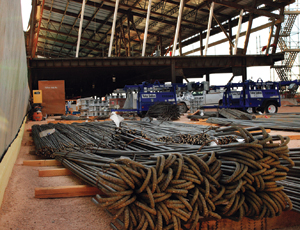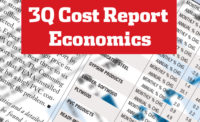Costs Post Rare Quarterly Decline
Construction costs took a major hit during the second quarter, with 14 of the 15 industry cost indexes tracked by ENR declining from the previous quarter. They were some of the biggest quarter-to-quarter declines ever recorded by ENR, averaging a 1.4% decline between January and April of this year.

The largest drops came from the “selling price” indexes, which reflect the intense bidding that is cutting both contractors’ and subcontractors’ margins to the bone. The Turner Construction Co.’s selling cost index fell 3.4% during the quarter, pushing the index 8.9% below the second quarter of 2008, when the market was still absorbing a record spike in steel prices. Likewise, Rider Levett Bucknall’s selling price index fell 5.1% this quarter and is 3.5% below a year ago.
While intense bidding competition was driving down selling prices, general purpose construction cost indexes, which just measure material and labor costs, also were falling. ENR’s building cost index fell 0.3% in the second quarter, but that drop was surpassed by quarterly declines of 1.0% for the Bureau of Reclamation general building cost index, 1.2% for the Marshall & Swift index, 2.0% for the R.S. Means building cost index and 2.1% for Power Advocate’s cost index for combined cycle powerplants.
Cost indexes put together by the U.S. Dept. of Commerce showed quarterly declines of 0.8% for new warehouses and 0.9% for office building construction. Commerce’s cost index for new schools was the only index posting an increase this quarter, with a 0.3% gain.
Despite the quarterly declines, most general-purpose building cost indexes still reflect the spike in steel prices during the first half of 2008 and show year-to-year increases ranging from 1.1% to 6.1%. Breaking away from the pack is Commerce’s index for new school construction, which in April was up 11.5% over a year ago.
The depressed housing market has floored prices for lumber, plywood and wallboard. Lumber prices in particular are still seeking a bottom after five years of declines. Eugene, Ore.-based pricing specialist Random Lengths reports the average mill price of framing lumber in May was $198 per thousand board ft, down 29% from May 2008 and 57% from its peak in May 2004. This drop helped to undercut Commerce’s cost index for new single-family housing by 1.7% this quarter. The single-family index is now 7.4% below April 2008’s level, which follows an annual decline of 3.8% in 2007.
“We expect the single-family housing market to only reach 550,000 units this year,” says Armine Thompson, the construction materials analyst for Washington, D.C.-based forecasting firm IHS Global Insight. “We don’t expect housing to get back to the million-unit mark until 2011. It’s going to be a very slow recovery.” The outlook for nonresidential work is becoming just as bleak, with Global Insight predicting a 12% decline in nonresidential work this year, followed by another 18% drop in 2010.
The shrinking market has contractors and subs scrambling for work. “We have people coming in short and underbidding projects just to get work. It is like they are counting on change orders to save them,” says John Marino, chief estimator with the Sierra West Group, which compiles the two Lee Saylor cost indexes (LSI) published in this issue. “We expect to see a lot of litigation in the future because you are not getting the best quality contractor with some of these hard low bids.”
The intensity of this competition is reflected in the narrowing gap between the LSI general materials/labor index and the LSI subcontractor index. The subcontractor index is only up 1.1% from a year ago, compared to a 3.1% increase for the materials/labor index. The difference is due to subcontractors taking most of the profit margin out of their bids, says Sierra West’s president Mary Wallers.
Most of the decline in this quarter’s cost indexes can be tied to the collapse in steel prices. Prices for structural steel, which accounts for 22% of ENR’s Building Cost Index, fell 3% this quarter. The steel component of the LSI materials/labor index also declined 3% during the last three months. However, the steel component of most indexes is based on list prices, which often don’t fully reflect the dramatic declines in transaction prices.
“The mill published prices are window dressing; no one is paying those prices,” says Noel DeKing, U.S. markets editor for Platts Steel Markets Daily. Like ENR, Platts is owned by the McGraw-Hill Cos. “We hear that some projects are being bid 20% below targeted budgets because of lower material prices.”
DeKing says the mill list price for grade-60 reinforcing bar is currently around $32 per cwt, but users surveyed are paying closer to $24. That price is 52% lower than in August 2008, when Platts reported a selling price for grade-60 rebar of $50 per cwt.
Likewise, Platts’ price for A36 structural steel plate is currently $29.50 per cwt, which is down 59% from August 2008, when Platts reported prices of $72.25 per cwt.
DeKing says federal stimulus spending has yet to make an impact on prices for steel needed for construction. “In the steel business, rebar and structural steel for highways and bridge construction account for the lion’s share of the federal stimulus infrastructure spending,” says DeKing. “As a benchmark, about 100 tons of rebar is used in a mile of [concrete] highway construction, so if it’s a four-lane highway, that’s 400 tons of rebar for every mile. Right now, steel prices have shown very little response to stimulus spending. Our sources are not reporting any significant increase in demand.”




